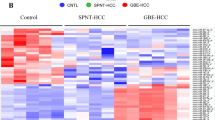Abstract
Epigallocatechin gallate (EGCG), a major type of green tea polyphenol, has been reported to cause hepatotoxicity when used in excess. Micro-RNAs (miRNAs) are small non-coding RNA molecules that functions as negative regulators of gene expression. They play an important role in the regulation of genes involved in the cellular and molecular responses to toxicants. To examine miRNA regulatory effect on global gene expression in EGCG-treated HepG2 cells, we performed pair-wise correlation coefficient analysis on expression levels of 22 miRNA and 27,419 mRNA, and observed negative correlations (r< −0.7) between miRNA and mRNA. We identified a total of 234 negative correlated miRNA-mRNA pairs. Gene Ontology analysis on the miRNA-correlated genes revealed significant enrichment in the several biological processes related to organic acid metabolic process, carboxylic acid metabolic process and cellular protein catabolic process. Connectivity map analysis also revealed that the expression signatures of EGCG were very similar to those of polyphenol gossypol which is hepatotoxic to animal and human.
Similar content being viewed by others
References
Filipowicz, W., Bhattacharyya, S. N. & Sonenberg, N. Mechanisms of post-transcriptional regulation by microRNAs: are the answers in sight? Nat Rev Genet 9:102–114 (2008).
Wu, L. & Belasco, J. G. Let me count the ways: mechanisms of gene regulation by miRNAs and siRNAs. Mol Cell 29:1–7 (2008).
Griffiths-Jones, S., Saini, H. K., van Dongen, S. & Enright, A. J. miRBase: tools for microRNA genomics. Nucleic Acids Res 36(Database issue):D154–158. Epub (2007).
Miska, E. A. How microRNAs control cell division, differentiation and death. Curr Opin Genet Dev 15: 563–568 (2005).
Ørom, U. A., Nielsen, F. C. & Lund, A. H. Micro-RNA-10a binds the 5’UTR of ribosomal protein mRNAs and enhances their translation. Mol Cell 30:460–471 (2008).
Isbrucker, R. A. et al. Safety studies on epigallocatechin gallate (EGCG) preparation. Part3: teratogenecity and reproductive toxicity studies in rats. Food Chem Toxicol 44:651–661 (2006).
Galati, G., Lin, A., Sultan, A. M. & O’Brien, P. J. Cellular and in vivo hepatotoxicity caused by green tea phenolic acids and catechins. Free Radic Biol Med 40:570–580 (2006).
Pennie, W. D., Woodyatt, N. J., Aldridge, T. C. & Orphanides, G. Application of genomics to the definition of the molecular basis for toxicity. Toxicol Lett 120:353–358 (2001).
Hudder. A. & Novak, R. F. miRNAs: effectors of environmental influences on gene expression and disease. Toxicol Sci 103:228–240 (2008)
Wang, L. et al. Genome-wide transcriptional profiling reveals microRNA-correlated genes and biological processes in human lymphoblastoid cell lines. PLoS One 4:e5878 (2009).
Liu, T. et al. Detection of a microRNA signal in an in vivo expression set of mRNAs. PLoS One 2:e804 (2007).
Gammell, P. MicroRNAs: recently discovered key regulators of proliferation and apoptosis in animal cells: Identification of miRNAs regulating growth and survival. Cytotechnology 53:55–63 (2007).
Diodovich, C. et al. Modulation of different stress pathways after styrene and styrene-7, 8-oxide exposure in HepG2 cell line and normal human hepatocytes. J Appl Toxicol 26:317–325 (2006).
Hwang, H. W. & Mendell, J. T. MicroRNAs in cell proliferation, cell death, and tumorigenesis. Br J Cancer 94:776–780 (2006).
Elliott, M. J., Dong, Y. B., Yang, H. & McMasters, K. M. E2F-1 up-regulates c-Myc and p14 (ARF) and induces apoptosis in colon cancer cells. Clin Cancer Res 7:3590–3597 (2001).
Janumyan, Y. M. et al. Bcl-xL/Bcl-2 coordinately regulates apoptosis, cell cycle arrest and cell cycle entry. EMBO J 22:5459–5470 (2003).
Ahn, J. I. et al. High-concentration epigallocatechin gallate treatment causes endoplasmic reticulum stressmediated cell death in HepG2 cells. Genomics & Informatics 7:97–106 (2009).
Lynn, F. C. Meta-regulation: microRNA regulation of glucose and lipid metabolism. Trends Endocrinol Metab 20:452–459 (2009).
Nichols, K. D. & Kirby, G. M. Microarray analysis of hepatic gene expression in pyrazole-mediated hepatotoxicity: identification of potential stimuli of Cyp2a5 induction. Biochem Pharmacol 75:538–551 (2008).
Gilmore, W. J. & Kirby, G. M. Endoplasmic reticulum stress due to altered cellular redox status positively regulates murine hepatic CYP2A5 expression. J Pharmacol Exp Ther 308:600–608 (2004).
Cheng, J. S. et al. Effect of gossypol on intracellular Ca2+ regulation in human hepatoma cells. Chin J Physiol 46:117–122 (2003).
Lei, X. et al. Gossypol induces Bax/Bak-independent activation of apoptosis and cytochrome c release via a conformational change in Bcl-2. FASEB J 20:2147–2149 (2006).
Author information
Authors and Affiliations
Corresponding author
Rights and permissions
About this article
Cite this article
Ahn, JI., Jeong, K.J., Ko, MJ. et al. Changes of miRNA and mRNA expression in HepG2 cells treated by epigallocatechin gallate. Mol. Cell. Toxicol. 6, 169–177 (2010). https://doi.org/10.1007/s13273-010-0024-3
Received:
Accepted:
Published:
Issue Date:
DOI: https://doi.org/10.1007/s13273-010-0024-3




